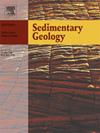Bridging the gap: Anatomy of recently growing calcareous crusts in the Bohemian Karst (Czech Republic)
IF 2.9
2区 地球科学
Q1 GEOLOGY
引用次数: 0
Abstract
This study presents the results of a combined field and microscopy investigation of an unusual hybrid type of carbonate crust that precipitated in subaerial outcrops of Lower Palaeozoic limestone in the Bohemian Karst. The crusts formed pendant, up to 6 cm thick, stalactite-like deposits that filled various cavities within fractured limestone beds. Two distinct microfacies were identified in the crusts: highly porous, coarsely crystalline aggregates that host abundant moss stems, interpreted as bryophyte tufa, and tiny, hemispheroidal, mushroom-shaped coralloids. In some of the thicker crusts, both microfacies coexist in close proximity. However, more commonly, the bryophyte tufa is found in open tectonic fractures and dissolution grooves along limestone bedding planes in sunnier areas of the outcrops, while coralloids dominate in darker, wetter environments such as small crevice caves and the shadowed undersides of overhanging limestone beds and flat limestone cobbles.
The coralloids exhibit a distinct, fine internal lamination consisting of convex outward, rhythmically alternating dark and light-colored calcite laminae. The dark laminae are enriched with clay minerals, organic debris, detrital grains, and fine Fe![]() Mn pigments, which are derived from the limestone bedrock, nearby relict terra rossa paleosoils, and the overlying rendzinic soil cover. These materials were concentrated during thaw or heavy rainfall events. Cathodoluminescence (CL) microscopy of the coralloids revealed vividly luminescent zoning, characteristic of abrupt changes in the composition and reducing potential of the seeping water, which cyclically repeated during speleothem growth. Characteristic peloidal clotted textures, indicative of microbial influence, were also observed in many laminae. This, along with the stromatolitic character of the lamination and the presence of various microorganisms—including actinobacteria, algae, fungi, and bacteria identified on the coralloid exteriors—collectively suggests that the formation of these speleothems likely involved biologically mediated phases.
Mn pigments, which are derived from the limestone bedrock, nearby relict terra rossa paleosoils, and the overlying rendzinic soil cover. These materials were concentrated during thaw or heavy rainfall events. Cathodoluminescence (CL) microscopy of the coralloids revealed vividly luminescent zoning, characteristic of abrupt changes in the composition and reducing potential of the seeping water, which cyclically repeated during speleothem growth. Characteristic peloidal clotted textures, indicative of microbial influence, were also observed in many laminae. This, along with the stromatolitic character of the lamination and the presence of various microorganisms—including actinobacteria, algae, fungi, and bacteria identified on the coralloid exteriors—collectively suggests that the formation of these speleothems likely involved biologically mediated phases.
Surface calcite rhombs on the calcareous crusts were corroded, exhibiting well-developed etch pits, and spiky and ribbon-like calcite crystallites exposed within the cores of severely etched crystals. These erosional effects, likely due to bacterial or fungal activity, suggest that the longevity of these deposits in the rock record may be limited. This is further supported by the relatively young age of the crusts (30 to 70 years), determined through radiocarbon dating and field observations. It is proposed that these recently growing calcareous crusts represent a hybrid, transitional form of carbonate deposits, bridging the gap between biologically influenced calcareous bryophyte tufa and typical speleothems, akin to those recently discovered in the twilling zone of some tropical caves.
弥合鸿沟:波西米亚喀斯特(捷克共和国)最近生长的钙质结壳的解剖
本文介绍了对波希米亚喀斯特下古生代石灰岩地面露头中沉淀的一种不寻常的混合型碳酸盐地壳的野外和显微研究结果。地壳形成了垂坠状的、厚达6厘米的钟乳石状沉积物,填满了破碎的石灰岩床中的各种洞穴。在地壳中发现了两种不同的微相:一种是多孔的、粗结晶的聚集体,上面有大量的苔藓茎,被解释为苔藓凝灰岩;另一种是微小的、半球形的、蘑菇状的珊瑚。在一些较厚的地壳中,两种微相紧密共存。然而,更常见的是,苔藓植物凝灰岩在露头较阳光的地区沿石灰岩层理平面的开放构造裂缝和溶解槽中发现,而珊瑚类则在较暗、较潮湿的环境中占主导地位,如小裂缝洞和悬垂石灰岩床和平坦石灰岩鹅卵石的阴影底面。珊瑚状体表现出明显的、精细的内部层状结构,由向外凸出的、有节奏地交替的深色和浅色方解石层状组成。暗色纹层富含粘土矿物、有机碎屑、碎屑颗粒和细小的FeMn色素,它们来源于石灰岩基岩、附近的红土古土壤和上覆的人脂质覆盖层。这些物质在解冻或强降雨期间集中。珊瑚体的阴极发光显微镜显示出鲜明的发光分带,具有渗水成分和还原电位突变的特征,这种变化在洞穴体生长过程中循环重复。在许多纹层中还观察到特征的球囊凝块结构,表明微生物的影响。这一点,连同叠层的叠层特征和各种微生物的存在——包括在珊瑚状表面发现的放线菌、藻类、真菌和细菌——共同表明,这些洞穴的形成可能涉及生物介导的阶段。钙质结壳表面方解石菱形被腐蚀,显示出发育良好的蚀刻坑,在严重蚀刻的晶体芯内暴露出尖刺状和带状方解石晶体。这些侵蚀作用,可能是由于细菌或真菌的活动,表明这些沉积物在岩石记录中的寿命可能有限。通过放射性碳定年法和实地观测确定的地壳相对较年轻(30至70年)进一步支持了这一点。有人提出,这些最近生长的钙质结壳代表了碳酸盐矿床的混合过渡形式,弥合了受生物影响的钙质苔藓凝灰岩和典型洞穴之间的差距,类似于最近在一些热带洞穴的扭曲区发现的那些。
本文章由计算机程序翻译,如有差异,请以英文原文为准。
求助全文
约1分钟内获得全文
求助全文
来源期刊

Sedimentary Geology
地学-地质学
CiteScore
5.10
自引率
7.10%
发文量
133
审稿时长
32 days
期刊介绍:
Sedimentary Geology is a journal that rapidly publishes high quality, original research and review papers that cover all aspects of sediments and sedimentary rocks at all spatial and temporal scales. Submitted papers must make a significant contribution to the field of study and must place the research in a broad context, so that it is of interest to the diverse, international readership of the journal. Papers that are largely descriptive in nature, of limited scope or local geographical significance, or based on limited data will not be considered for publication.
 求助内容:
求助内容: 应助结果提醒方式:
应助结果提醒方式:


